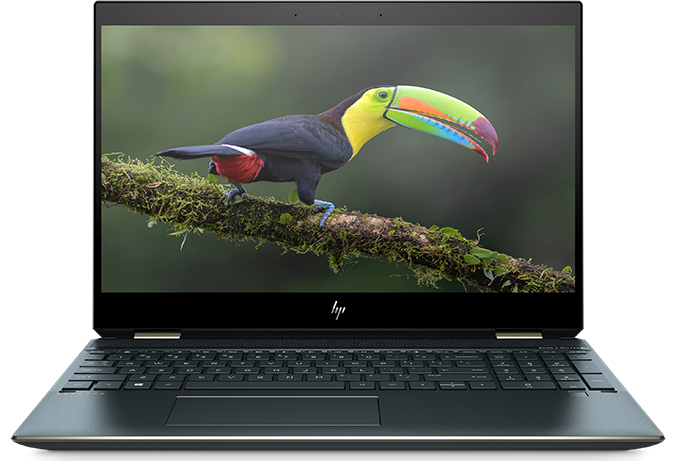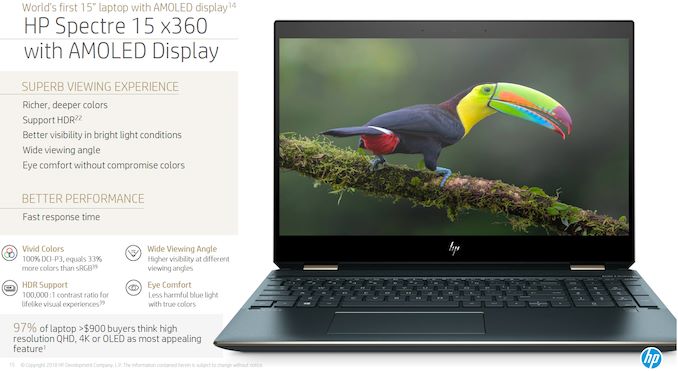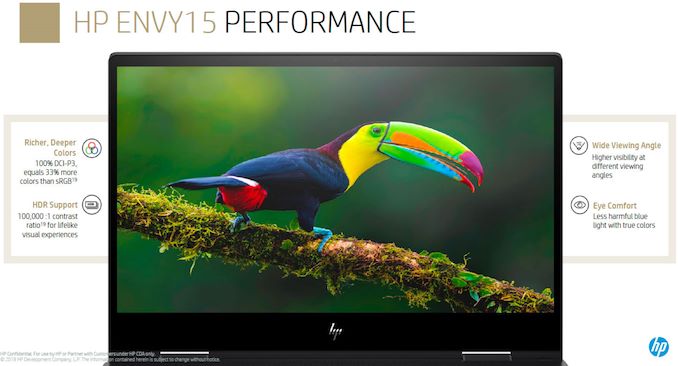HP to Introduce AMOLED Envy and Spectre Laptops in April
by Anton Shilov on March 28, 2019 6:00 PM EST- Posted in
- Laptops
- HP
- AMOLED
- Convertible
- Notebooks
- OLED
- Spectre x360
- Envy x360

HP is on track to start sales of laptops featuring a 15.6-inch AMOLED display in April, the company said recently. The first systems to get the innovative screens will be the company’s Envy and Spectre convertible notebooks that will first be available in Europe and the US.
HP introduced the Spectre x360 15, its first laptop with a 15.6-inch AMOLED display, back at CES 2019. Last week the company disclosed that apart from the said machine, it will also offer a premium version of its Envy x360 15 featuring the same panel. HP will reveal exact specifications of its ultra-thin 15.6-inch laptops with AMOLED displays at a later date, the only thing we do know about them at this time is that they will be based on Intel’s Core ‘Whiskey Lake’ CPUs. Meanwhile, given premium pricing of AMOLED screens, it is reasonable to expect these machines to be offered with other high-end components (GPU, SSD, Wi-Fi, etc.).
The manufacturer plans to start selling the HP Spectre x360 15 convertible via HP.com on April 19 with retail availability through Best Buy expected in May. The Envy x360 15 convertible laptop will be available next month in Europe first, whereas its US launch date will be announced separately, the company said.
Interestingly, HP also has not published many details about the 15.6-inch AMOLED panel it plans to use. So far the only company that has announced a 15.6-inch AMOLED display for laptops so far is Samsung Display. This panel has a 3840×2160 resolution, a brightness level ranging from 0.0005 to 600 nits, a dynamic contrast ratio of 120,000:1, a very low response time, and wide horizontal viewing angles. The screen can reproduce 100% of the DCI-P3 color gamut, which is considerably more accurate when compared to LCDs available today. Furthermore, the monitor carries VESA’s DisplayHDR True Black badge thus supporting at least HDR10 spec. Keep in mind though that HP might use a different panel or different grade of panel.
Related Reading:
- HP at CES 2019: HP Spectre x360 15 Gets AMOLED Display
- Samsung Unveils 15.6-Inch Ultra-HD OLED Display for Laptops
- Lenovo at CES 2019: Yoga C730 Gets AMOLED Display
- Dell at CES 2019: Alienware 55-Inch 4K 120 Hz OLED Gaming Monitor Showcased
Source: HP












41 Comments
View All Comments
Reflex - Thursday, March 28, 2019 - link
Is there any info on how they handle screen burn in on PC OLED's? TV's have less of a problem there as they do pixel shifting and have fewer static screen elements, but for computers it seems like it would be difficult to avoid.I'm very curious, my LG TV makes me desperately want one of these for my PC (everything looks drab on my current Dell UltraSharps) but afraid to invest in such screens even at reasonable prices if they will have burnin inside of a year or two...
SaturnusDK - Thursday, March 28, 2019 - link
Absolutely zero problems with burn in.I have the HP x360 Spectre 13.3" 2560x1440 OLED from CES 2016 as my daily driver. I use it 12-14 hours every single day. Mainly for work or work related tasks that involves having the same type of screen opened for hours on end, and I do not have even a hint of burn in.
Granted, I've used the dark mode as far as possible because I was also slightly worried about it but I realized that compared to these burn in tests you often see referenced, laptops have a major difference in use. The TVs and monitors you see in those tests run 24/7 at very high brightness, and that's exactly you should avoid. OLED screen needs to rest for a few hours every day 24/7 use is not suited for organic materials, and high brightness means you stress them needlessly.
My screen is blindingly bright at max and I have no problem reading it outside in the Sun (obvious not with direct Sun light on the screen), and I don't use it over 80% brightness setting in most conditions as it would otherwise simply be uncomfortably bright.
Samus - Friday, March 29, 2019 - link
I think the real future of OLED is QLED (which is basically just as good while not being organic) because the lifespan is substantially better and it is cheaper to manufacture. OLED was cool but it just isn't cost effective and is going to be replaced by scalable manufacturing technologies.That isn't to say OLED isn't superior at many things. In the same way plasma televisions were superior to LCD televisions, they died because the con's outweighed the pro's compared to the general performance on continually improving\evolving LCD displays.
OLED is no exception. Quantum LED (not to be confused with quantum dot backlighting - completely different!) has many of the benefits of OLED without the cost.
Azune - Friday, March 29, 2019 - link
I've never heard of Quantum LEDs before. Do you mean MicroLED with quantum dots for wider color space? Or could you link to a site with information about this technology?skavi - Friday, March 29, 2019 - link
Quantum dots can be electroluminescent. In theory, you could use them directly as subpixels.Death666Angel - Friday, March 29, 2019 - link
Everything that Google gives me says that QLED/Quantum LED/Quantum dot backlighting is the same thing. And using "LCD displays" does not inspire great confidence in your technical knowledge, mate.skavi - Friday, March 29, 2019 - link
Before Samsung misappropriated the term, QLED referred to a possible future display tech which utilized the electroluminescent properties of QDs to use them directly as subpixels. Current Samsung "QLED" displays just use QD's photoluminescence to improve backlight quality.Valantar - Friday, March 29, 2019 - link
"QLED" is a marketing name for a specific form of LED-backlit LCD displays with quantum dots implemented in the backlighting to expand the reproducible color space. It improves on most other LED backlight systems (though not necessarily other quantum dot systems, as they're all relatively comparable), but that doesn't mean it's an actual OLED competitor, no matter how much Samsung wants to present it as such.skavi - Friday, March 29, 2019 - link
Before Samsung misappropriated the term, QLED referred to a possible future display tech which utilized the electroluminescent properties of QDs to use them directly as subpixels. Current Samsung "QLED" displays just use QD's photoluminescence to improve backlight quality.FreckledTrout - Friday, March 29, 2019 - link
Samus you are confusing a few technologies. QLED is not inorganic OLED it is simply Samsung's marketing term for quantum dot LED which just improves the backlight. MicroLED which Samsung is working on is an inorganic OLED.